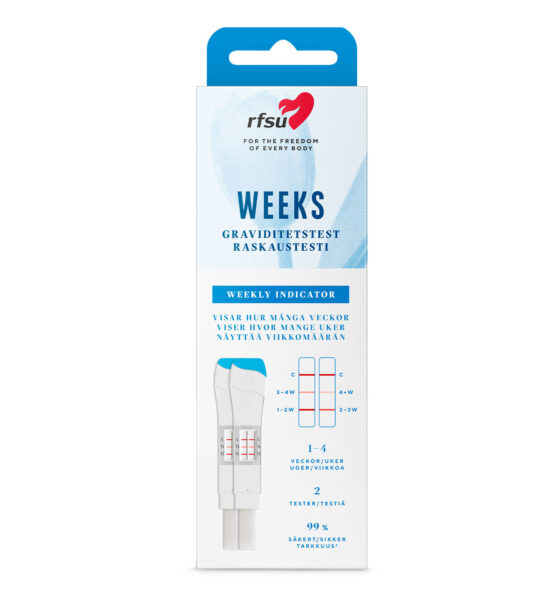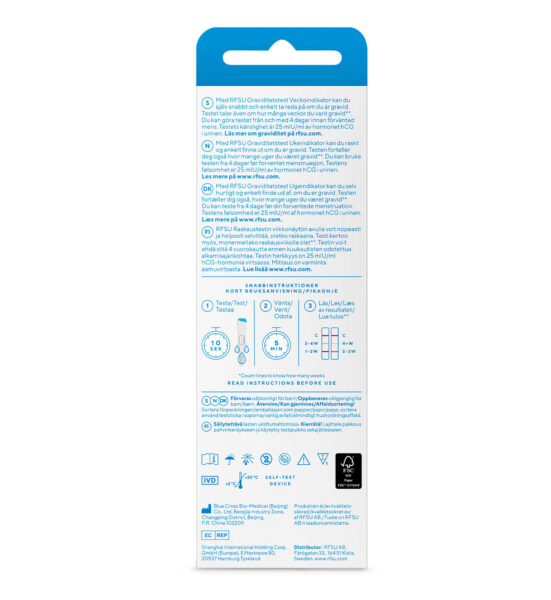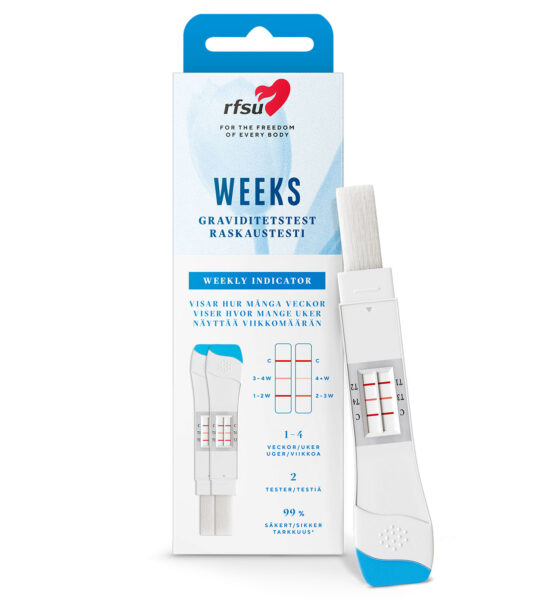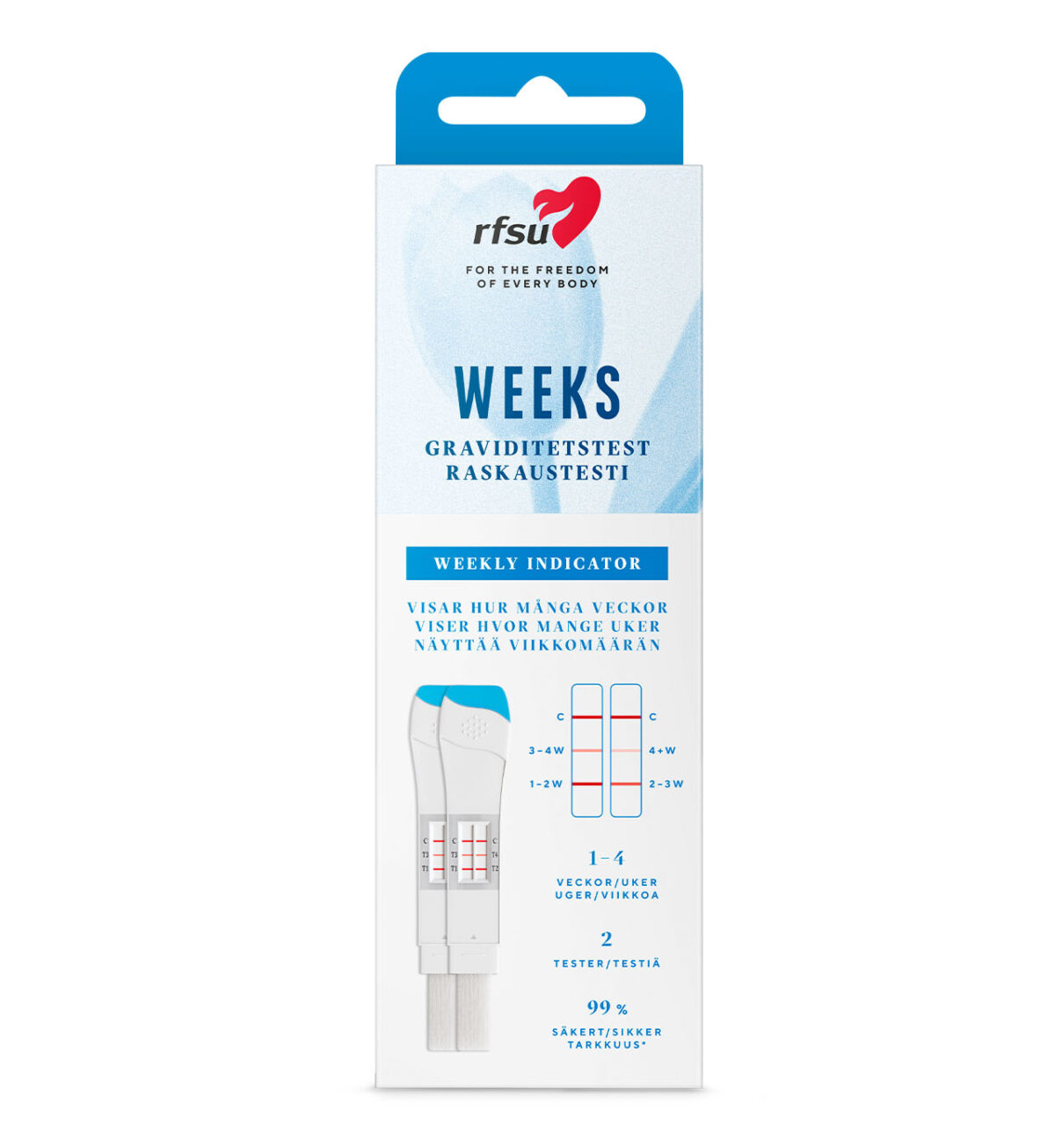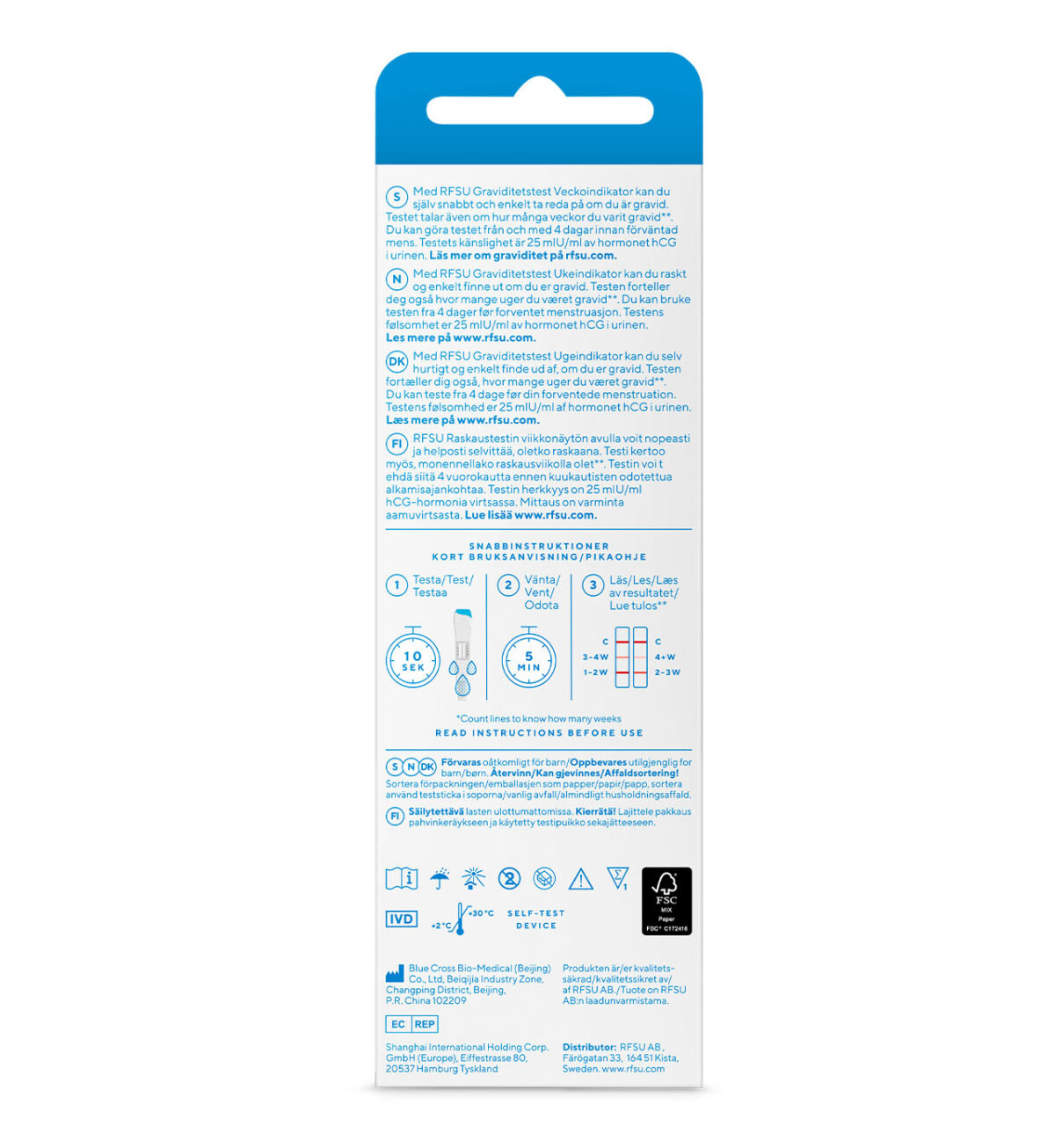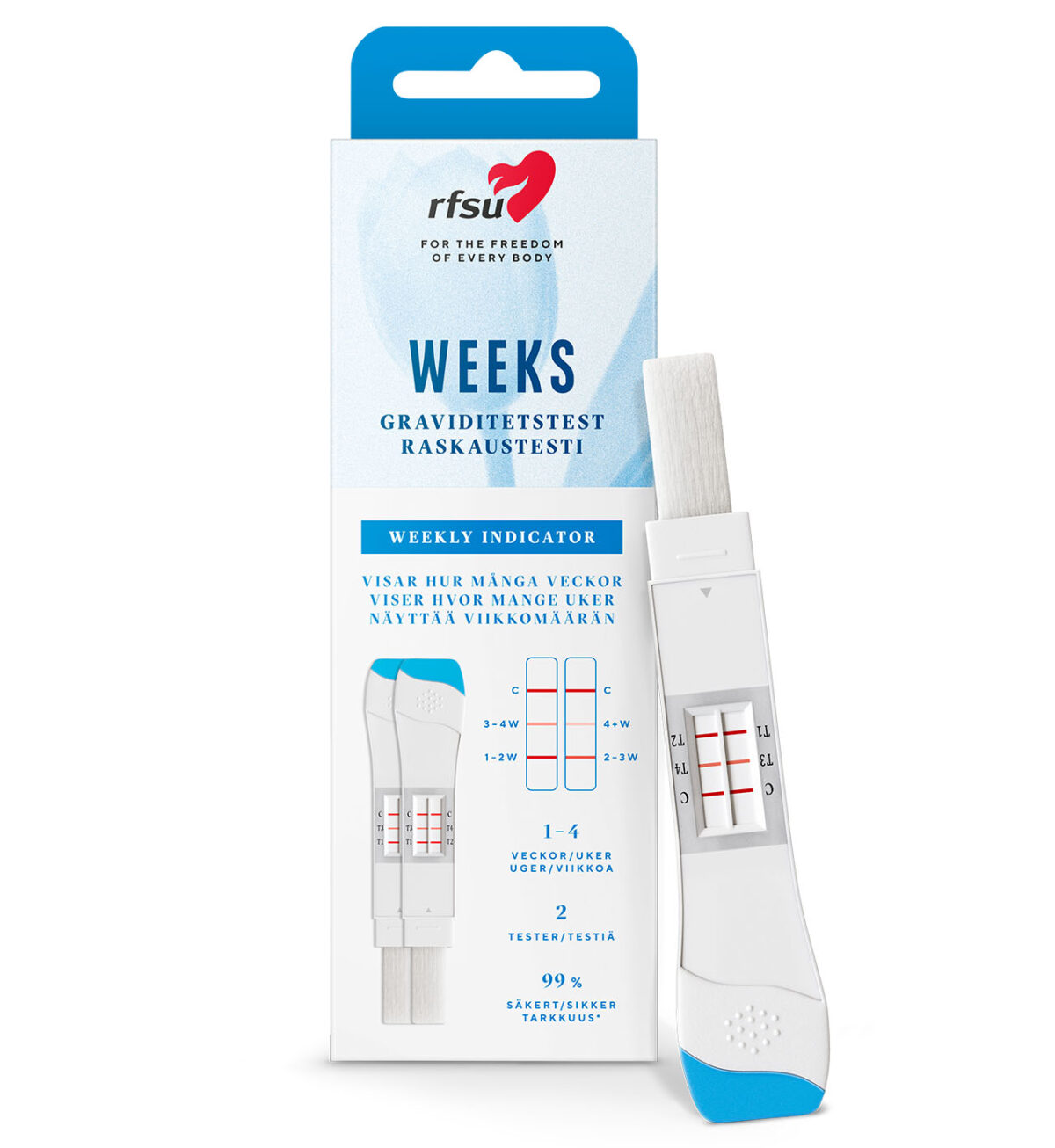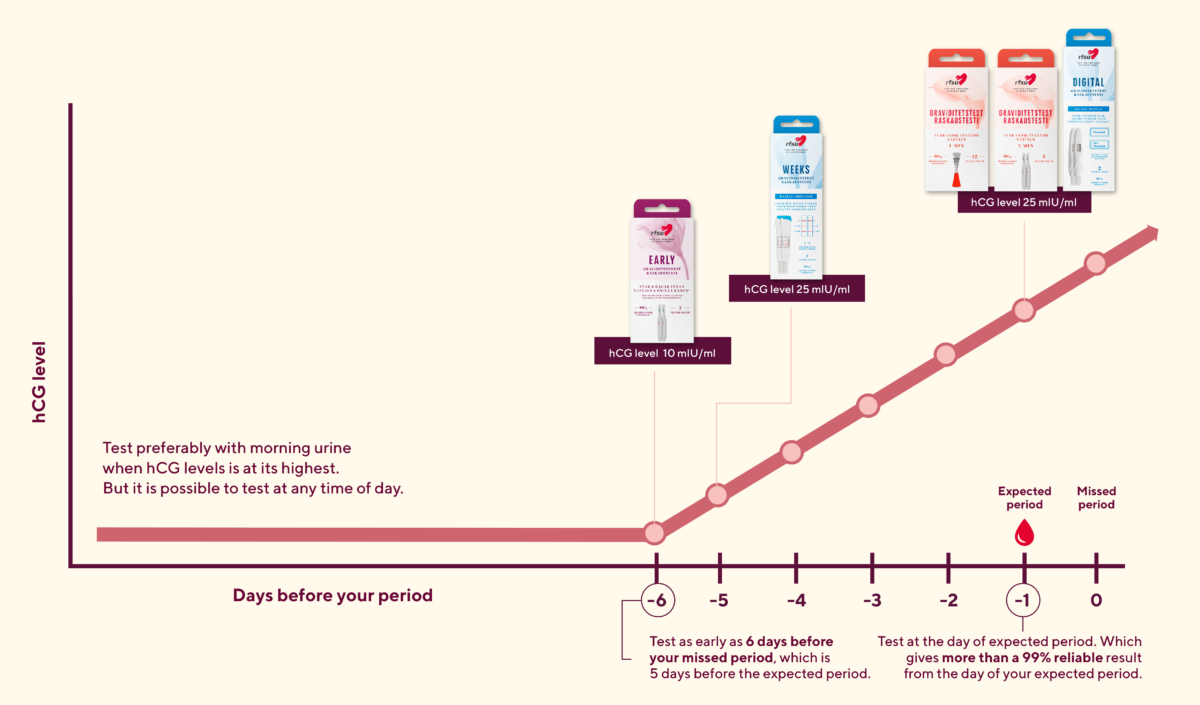-
Read more
With RFSU Weeks Pregnancy Test, you can quickly and easily find out if you are pregnant. With Weeks, you get two tests in one, as it shows whether you are pregnant or not, but also how far along you are in your pregnancy. The test has a smart week indicator function that indicates how many weeks have passed since conception. Shows clear results with easy-to-read lines. The test has 4 different test lines to show the number of weeks pregnant (1-2 weeks, 2-3 weeks, 3-4 weeks, 4+ weeks).
About Pregnancy test Weeks from RFSU
- For single use.
- Self-test that detects hCG in urine.
- The test is over 99% reliable from the day you expect your period.
- Sensitivity: The test gives a result when the hCG level in urine is 25 mIU/ml or higher.
- The test is disposed of in household waste, the inner bag is sorted as plastic, the outer carton as paper.
![weeks-graviditetstest-med-veckoindikator-rfsu]()
-
How to measure hCG hormone
How is hCG hormone measured?
A pregnancy test, whether taken at home or by a midwife/doctor, measures the hormone hCG. When an egg is fertilised, the hCG hormone is excreted in the urine and continues to increase during the first part of pregnancy. By detecting hCG in the urine, it is possible to determine whether a woman is pregnant or not. hCG normally starts to be produced by the fertilised egg after it has attached to the wall of the uterus, usually around 6-10 days after fertilisation. The level then normally increases very rapidly, doubling about every three days during the first third of pregnancy. By the time of the expected period, most women will have produced enough hCG to see a positive result; that is, they will have achieved an hCG level of 25mIU/ml, or more.
However, as we are all different, there may be individual variations. Some women may therefore see a positive result a few days before their expected menstrual period, while others will have to wait some more time. If the test shows that you are pregnant, you can be confident that the result is correct as the tests are very sensitive. The test only indicates that hCG is present in the urine. It does not provide any information about the health of the pregnancy, its location, or how far along you are after passing 4-weeks since conception.
![how-to-measure-hcg-hormone-levels-rfsu]()
-
How to do the test
When can I do the test?
You can use the RFSU Weeks Pregnancy test as early as 4 days before your expected period.
If you test before your expected period, you should use morning urine. If you get a weak positive result or are unsure of the result, test again with morning urine 2 days later.
How do I read the result on the weekly indicator?
The RFSU Weeks Pregnancy Test has a smart week indicator function that indicates how many weeks have passed. If you answer ‘Pregnant’, count the number of lines to see how many weeks have passed since fertilisation. The result window has 4 different test lines (T1-T4) to show the number of weeks pregnant.
The RFSU Weeks Pregnancy Test has a smart week indicator function that indicates how many weeks have passed. If you answer “Pregnant”, count the number of lines to see how many weeks have passed since fertilisation. The result window has 4 different test lines (T1-T4) to show the number of weeks pregnant.
Number of weeks since fertilisation
- Pregnant 1-2 weeks (T1)
- Pregnant 2-3 weeks (T2)
- Pregnant 3-4 weeks (T3)
- Pregnant 4+ weeks (T4)
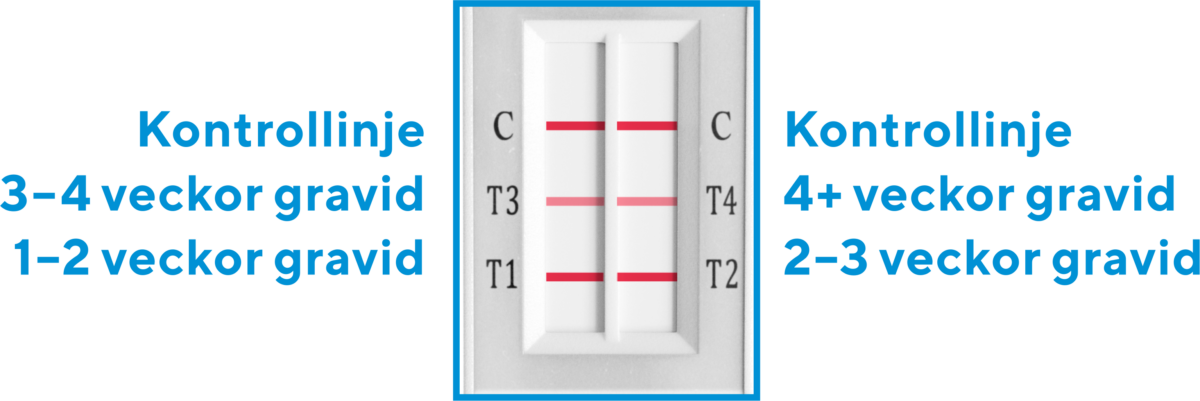
How to take the test – step by step
You can take the test at any time of the day, but morning urine is recommended when HCG levels are highest. Read the instructions carefully before you start. Here is a step-by-step description of how to take the test correctly.
- Open the package: take out the test stick and use it immediately. The test stick should be at room temperature when used.
- Remove the protective sleeve: The absorbent tip becomes visible.
- Hold the test correctly: with the result window up and the tip down.
- Test directly in the urine stream: Urinate directly onto the tip. Hold the test with the tip pointing downwards in the urine stream for 15-20 seconds. Important: Avoid getting urine on the result window. Continue to apply urine on the tip until you see both parts of the result window begin to react with a pink colour. Alternatively, collect urine in a clean, dry container and dip the tip into the urine for 15-20 seconds. Keep the tip in the urine sample until you see that both parts of the result window begin to react with a pink colour.
- Replace the protective cover.
- Place the test on a flat surface with the result window facing up.
- Wait for 1-5 minutes before reading the result.
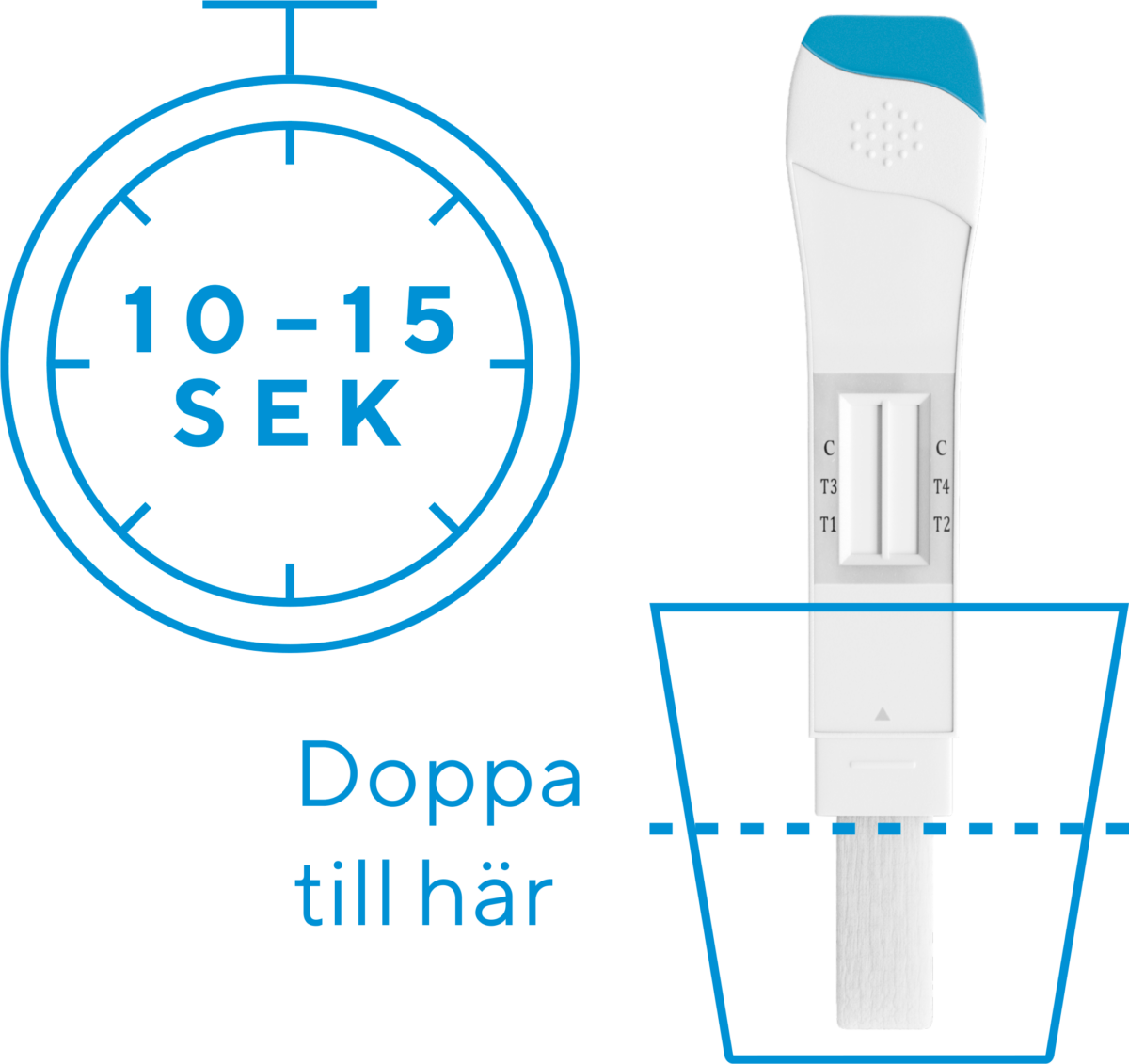
![weeks-graviditetstest-rfsu]()
Read the result
The test stick has 2 control lines (C) and 4 different test lines (T1-T4) to show the number of weeks pregnant.
Positive result – Pregnant
You are pregnant when at least three pink/red lines appear against a light background in the result area. Both of the two control lines (C) should be clearly visible as pink/red lines and also at least the test line T1 should be visible as a pink line, this means that you are most likely pregnant. If you test early (before your expected period) or get a weak positive result (light pink T1 line), you should retest 2 days later, preferably with the first morning urine. If you are pregnant, contact your midwife or gynaecologist for advice.
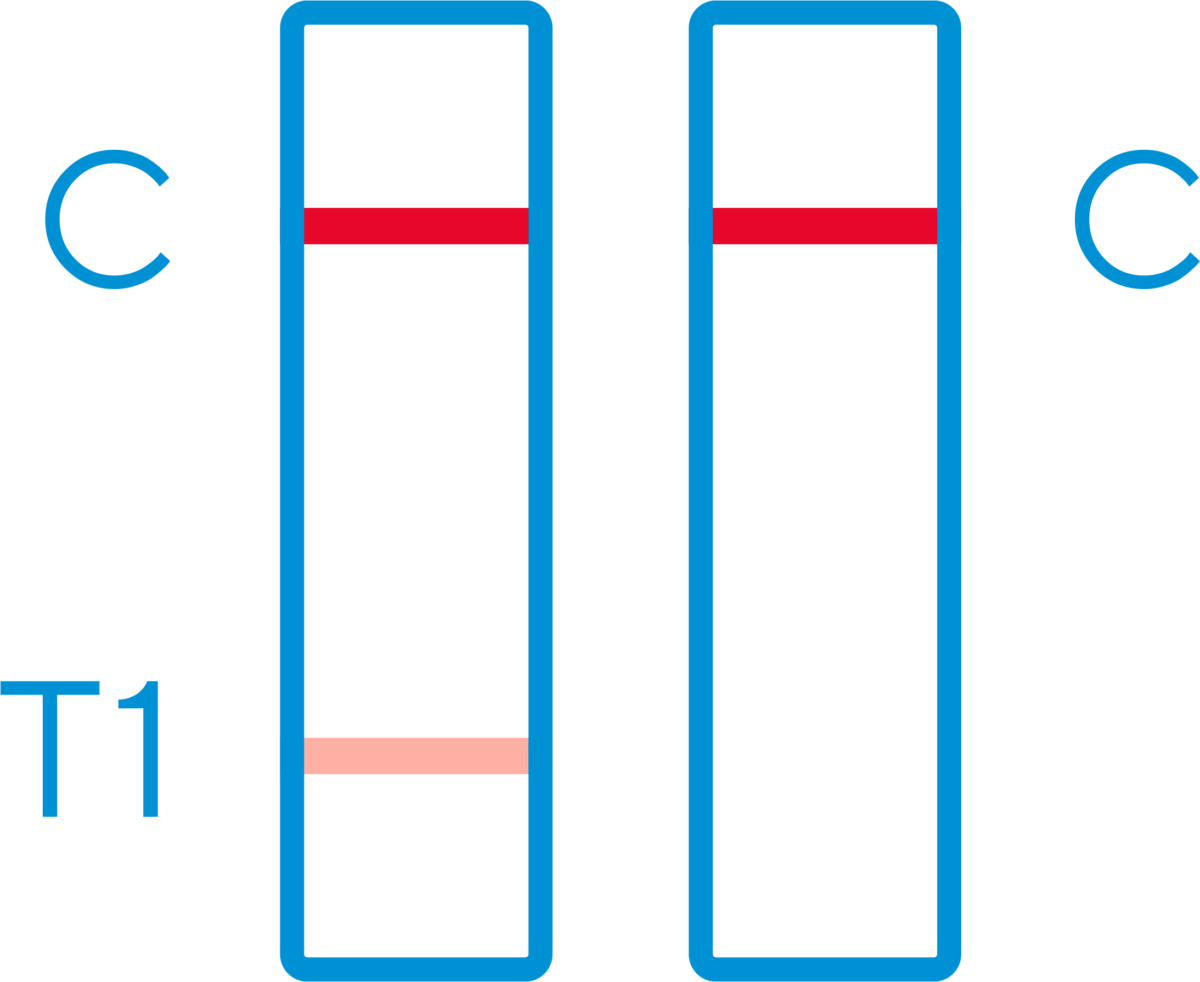
Reading the number of weeks of pregnancy
Count the number of lines to see how many weeks have passed since fertilisation. The colour of the test lines (T1-4) can vary from light pink to dark red, depending on the concentration of hCG in the urine.
- A: 1-2 weeks pregnant: Test line T1 appears as a pink line
- B: 2-3 weeks pregnant: Test line T1 appears as a pink/red line and test line T2 appears as a pink line.
- C: 3-4 weeks pregnant: Test lines T1 and T2 appear as pink/red lines and test line T3 appears as a pink line.
- D: 4+ weeks pregnant: Test lines T1 and T2 appear as pink/red lines and test lines T3 and T4 appear as pink lines.
![weeks-graviditetstest-rfsu]()
Negative result – not pregnant
If only the 2 control lines (C) appear in the result area, you are not pregnant. If you still do not get your period, take another test after 2 days, preferably with your first morning urine. If you get the same result and have not gotten your period, contact your midwife or gynecologist.
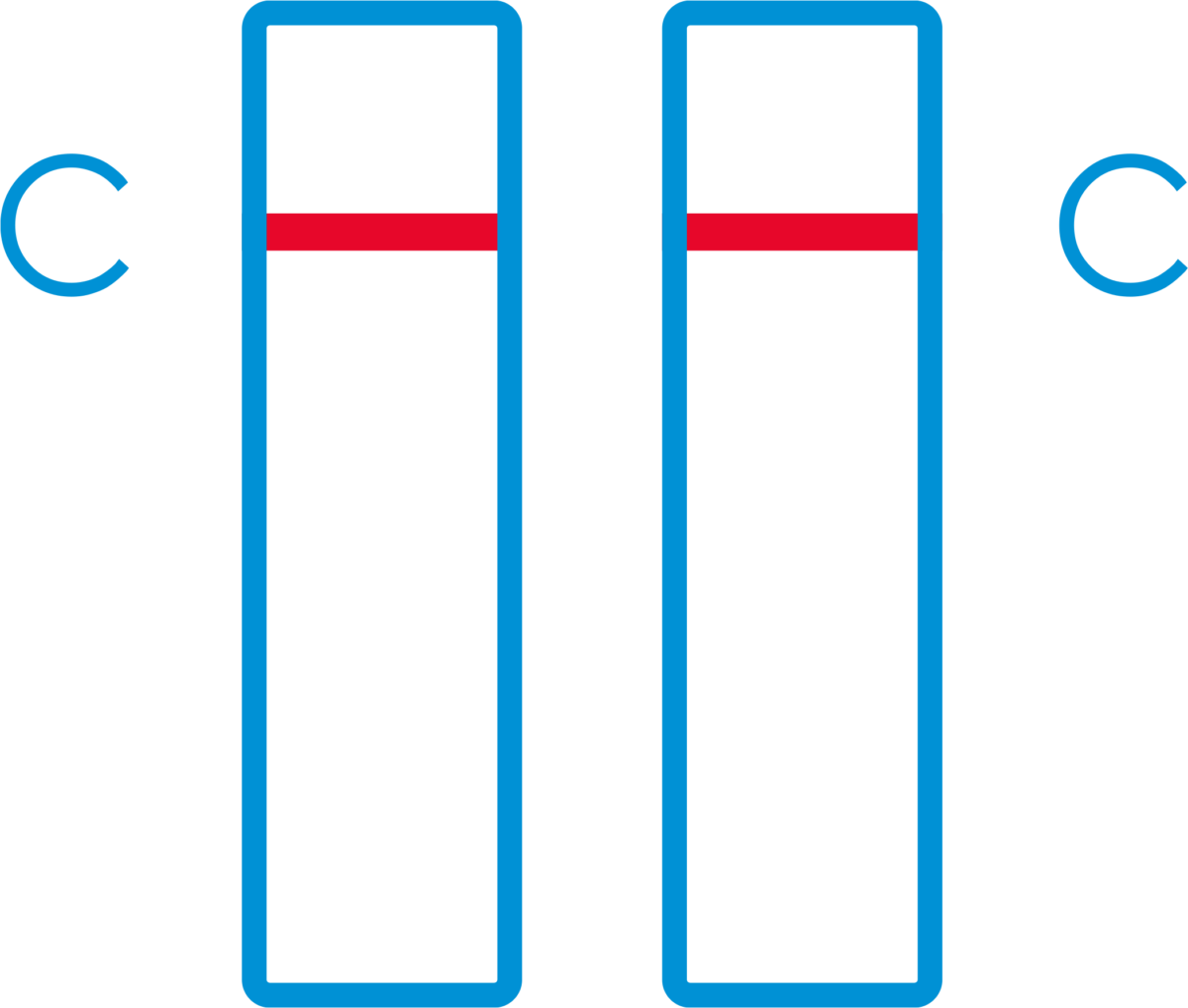
Invalid result
If no control line (C) is visible, no lines are visible at all, or the lines are a color other than pink/red, the test has not worked properly. This may be because the absorbent pad has not absorbed enough urine or because you have not performed the test correctly. Perform another test and follow the instructions carefully. If the problem persists, contact RFSU.
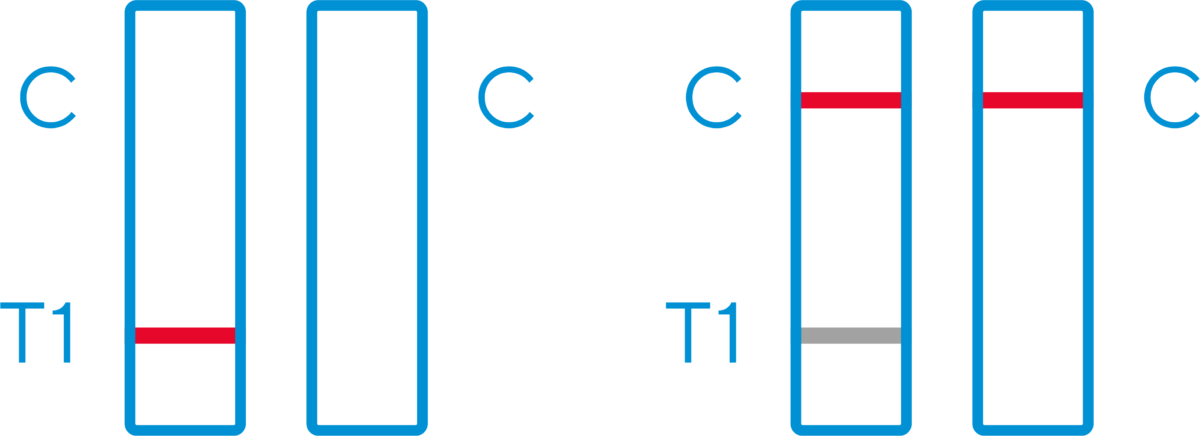
- How to use
-
FAQ
How reliable is the test?
RFSU Weeks Pregnancy test is more than 99% accurate from the day you expect your period. If you perform the test before your expected period and get the result ‘Not pregnant’, there is still a possibility that you are pregnant. In early pregnancy, the amount of pregnancy hormone normally increases very quickly. It is expected to double approximately every three days during the first third of pregnancy.
When can I start testing with RFSU Weeks Pregnancy test?
You can take the test as early as 4 days before your expected period. If you have irregular periods, test taking into account the longest menstrual cycle you have had in recent months. If you test early before your expected period and the test shows a negative or weak positive result, it is recommended to test again with morning urine 2 days later.
What is the best time of day to take a pregnancy test?
You can test at any time of the day, but it is safest to measure morning urine, when the hCG concentration is highest.
I have previously tested and received the result “pregnant”, but later received the result “not pregnant” or my period has arrived. What does this mean?
The test is 99% accurate in detecting the pregnancy hormone hCG from the day your period is due. It is entirely possible that you may get a result that shows “Pregnant”, but later receive a new test result that shows “Not pregnant” or by the start of your period. This could be due to a natural miscarriage during the early stages of pregnancy. This is not uncommon, as normally about one in four pregnancies unfortunately ends in an early miscarriage. If you get unexpected results, you should consult your midwife or gynecologist.
The test result only shows a faint line. What does this mean?
This could be because you are testing so early that the hCG level in your body has not yet had time to rise enough for the test to show the result as a strongly colored line. Even if the color of the test line is faint, i.e. the T1 line is only a light pink line, it indicates pregnancy. But to be on the safe side, we recommend that you test again in a day or two. The closer to your period, the stronger the hCG level in your urine and then you should get a stronger line, given that you are pregnant.
What do I do if the test shows “not pregnant”?
A negative test result means that no hCG has been identified in your urine or that the concentration of hCG is too low to be detected by the test (below 25 mIU/ml).
You may have made a mistake on the date of your expected period. In a normal menstrual cycle, bleeding usually occurs 12–14 days after ovulation. However, the time from the first day of bleeding to ovulation can vary more and this is what sometimes causes irregular periods.
If the test shows negative, it may be because your ovulation took place later than you think.
If you tested early, you should test again when your period is expected.
If your period is late, you should test again in about 1 week. If you get a negative result again and your period does not return, contact your midwife or gynecologist.
Can medications or certain illnesses affect the test result?
Birth control pills, painkillers, antibiotics or hormone treatments that do not contain hCG should not affect the test result.
Some medications that contain hCG can give misleading results. For example, fertility drugs that are taken by injection. If you test too early after such an injection, the test result may incorrectly show “Pregnant”.Other fertility treatments (e.g. clomiphene citrate), painkillers and hormonal contraceptives (e.g. birth control pills) do not affect the result.
If you have recently stopped hormonal contraceptives or are using fertility treatments such as clomiphene citrate, your periods may be irregular, which may cause you to test too early.Ectopic pregnancy, ovarian cysts, menopause, certain unusual illnesses or if your urine contains large amounts of bacteria can give misleading results.
Contact your midwife or gynaecologist if you get unexpected or inconsistent results.Will the result be affected by how much fluid I drink?
Very large fluid intake can dilute the urine, in which case the amount of hCG in the urine may not be detectable. You should therefore not change your usual fluid intake. You can increase the hCG concentration in the urine by drinking less and not urinating for about 2 hours before the test. It is safest to measure your first morning urine.
What if no line appears?
If no line appears at all, do a new test and follow the instructions for use carefully. This may be because you have not performed the test correctly. Or the absorbent part has not absorbed enough urine.
What colors are the lines that appear?
The color shade of the test line (T) can vary from light to dark pink/red, depending on the concentration of hCG in the urine. Both control lines (C) should be clearly visible as pink/red lines and at least the test line T1 should be visible as a pink line, this means that you are most likely pregnant. The shade of color does not affect the result, but only pink/red color gives a valid result, if you have a different color wait two days and do a new test.
How long does the result last before it fades or changes?
A positive result will usually remain unchanged, but the background may darken. Read the results within 5 minutes of performing the test, and any changes after 10 minutes should be ignored.


